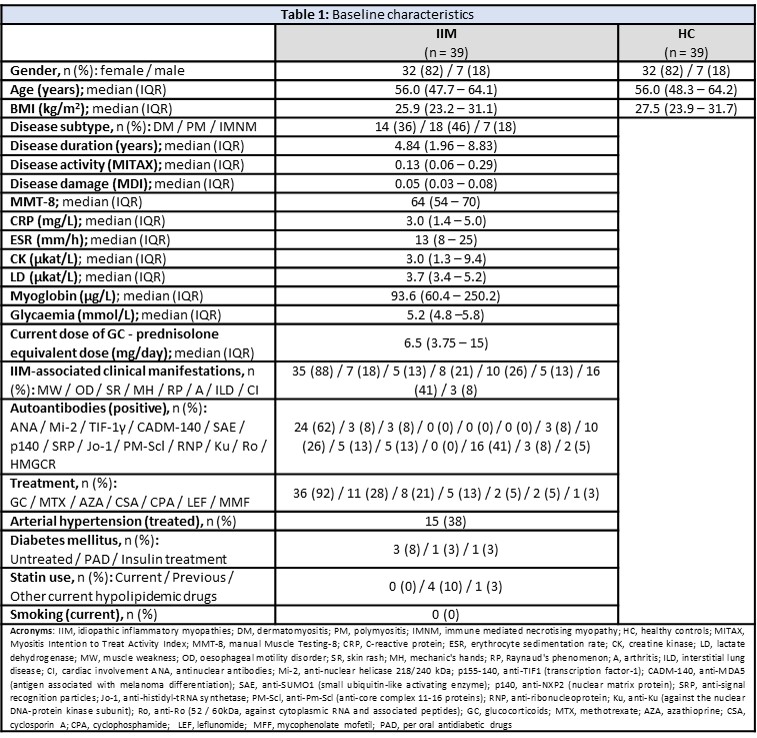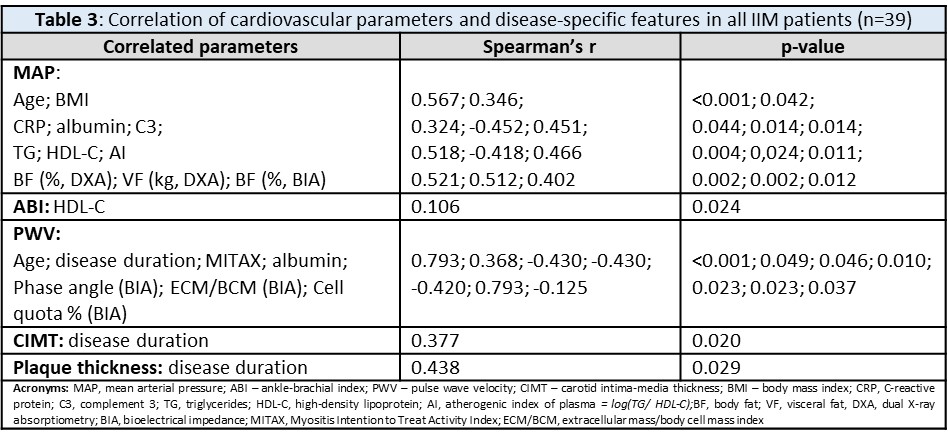Session Information
Session Type: Poster Session B
Session Time: 8:30AM-10:30AM
Background/Purpose: Idiopathic inflammatory myopathies (IIM) are associated with systemic inflammation, limited mobility, and glucocorticoid treatment, which can have a negative impact on metabolic disease, atherogenesis, and cardiovascular risk. The aim of this study was to assess the cardiovascular risk in IIM patients and healthy controls (HC) and the association with disease-specific features.
Methods: 39 patients with IIM (32 females; mean age 56; disease duration 4.8 years; DM 14 / PM 18 / IMNM 7) and 39 age-/sex-matched HC (32 females, mean age 56) without rheumatic diseases were included. DM and PM patients fulfilled the Bohan/Peter criteria, IMNM patients fulfilled the ENMC criteria. In both groups manifest cardiovascular disease (angina pectoris, myocardial infarction, cerebrovascular, and peripheral arterial vascular events) were excluded by case history. Disease activity and damage were evaluated by MITAX and MDI, muscle involvement by manual muscle testing (MMT-8), and comorbidities and current treatment were recorded. All participants underwent an examination of carotid intima-media thickness (CIMT), pulse wave velocity (PWV), ankle-brachial index (ABI), body composition (densitometry: iDXA Lunar, bioelectric impedance: BIA2000-M). Physical activity was evaluated by Human Activity Profile (HAP) questionnaire. The risk of fatal CV risk events was evaluated by SCORE (charts for the European population). Data are presented as median (IQR).
Results: In IIM, baseline characteristics, disease activity, the dose of glucocorticoids, prevalence of comorbidities were evaluated (Table 1). Compared to HC, there was no significant difference in IIM regarding blood pressure, ABI, PWV, CIMT and risk of fatal CV events by SCORE. In IIM, there was a higher frequency of plaques, but no difference in the plaque thickness. IIM group recorded significantly lower physical activity (Table 2). In IIM, blood pressure (represented as MAP) correlated positively with age, BMI, parameters of inflammation (CRP, C3), triglycerides, atherogenic index and body fat %, but negatively with albumin and HDL-C. Decreased (unfavourable) values of ABI were associated with low HDL-C. Increased PWV was associated with higher age, longer disease duration, decreased disease activity (MITAX), and unfavourable parameters of body composition and nutritional status (decreased phase angle and cell quota, and higher extracellular/body-cell-mass ratio). Increased (unfavourable) values of CIMT and plaque thickness were associated with longer disease duration (Table 3).
Conclusion: No significant differences in cardiovascular risk parameters between our IIM patients and healthy age-/sex-matched individuals were detected. However, in IIM, cardiovascular risk factors were associated with age, disease duration, dose of glucocorticoids, and parameters of lipidogram and body composition. No association with decreased physical activity was observed.
Acknowledgement: Supported by AZV NV18-01-00161A, MHCR-00023728, SVV-260373, and GAUK-312218.
To cite this abstract in AMA style:
Oreska S, Storkanova H, Spiritovic M, Hermankova B, Cesak P, Kudlicka J, Tuka V, Mikes O, Satny M, Chytilova E, Krupickova Z, Vrablik M, Pavelka K, Senolt L, Mann H, Vencovsky J, Tomcik M. Cardiovascular Risk in Myositis Patients Compared to General Population – Preliminary Data from a Single-centre Cross-sectional Study [abstract]. Arthritis Rheumatol. 2021; 73 (suppl 9). https://acrabstracts.org/abstract/cardiovascular-risk-in-myositis-patients-compared-to-general-population-preliminary-data-from-a-single-centre-cross-sectional-study/. Accessed .« Back to ACR Convergence 2021
ACR Meeting Abstracts - https://acrabstracts.org/abstract/cardiovascular-risk-in-myositis-patients-compared-to-general-population-preliminary-data-from-a-single-centre-cross-sectional-study/



